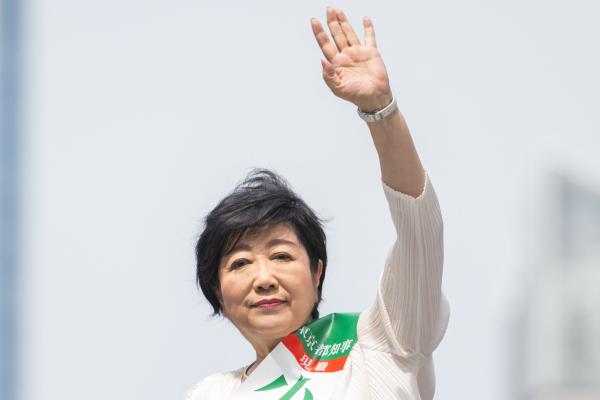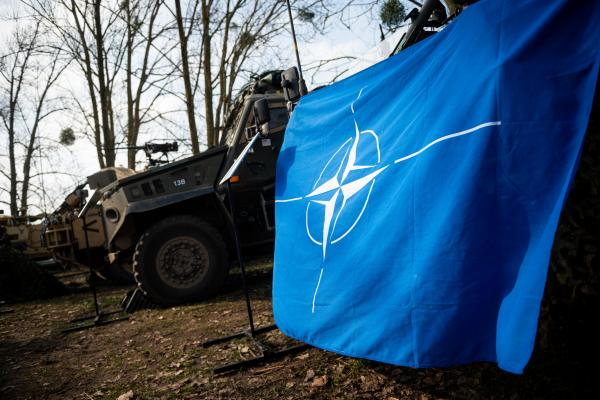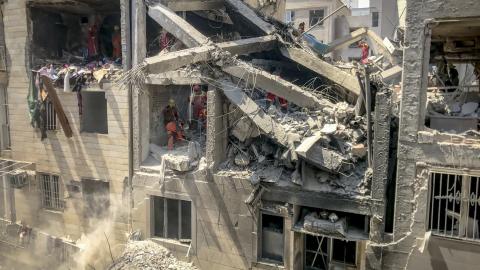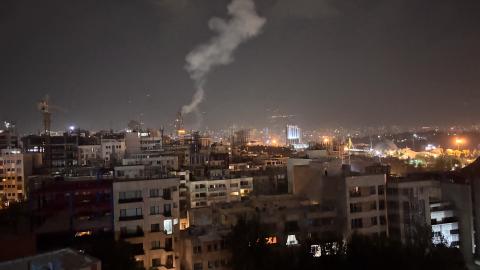
Adapting the US Nuclear Posture in Response to Adversary Threats


Deputy Director for Strategic Stability, Joint Chiefs of Staff, Directorate for Strategy, Plans, and Policy (J5)

Principal, Strategy to Plans LLC

Senior Fellow and Director, Keystone Defense Initiative
Rebeccah L. Heinrichs is a senior fellow and director of the Keystone Defense Initiative. She specializes in US national defense policy with a focus on strategic deterrence.
The United States will soon face two nuclear peer adversaries: the People’s Republic of China and the Russian Federation. But Washington designed its current nuclear modernization plan for a more benign threat environment with just one nuclear peer.
Join Senior Fellow Dr. Rebeccah L. Heinrichs, the director of Hudson’s Keystone Defense Initiative, for a discussion with Dr. Austin Long and Mr. Greg Weaver on ways the US can increase the credibility of its nuclear deterrent in a dangerous new era.
Event Transcript
This transcription is automatically generated and edited lightly for accuracy. Please excuse any errors.
Rebeccah Heinrichs:
Good morning. My name is Rebeccah Heinrichs and I am happy to welcome you to Hudson Institute, for those of you who are joining in person and those of you who are joining us online. Thank you for your patience. I’m sure it’ll be worth the wait. We have two great guests here today to talk about a critically important topic. We have Greg Weaver, he’s the Principal of Strategy to Plans LLC. Prior to this, he was the Deputy Director for Strategic Stability for the Joint Staff J5 strategy plans and the policy directorate. And then next to him, is the guy who has that job now, Dr. Austin Long. And so it’s just a real privilege to have Greg Weaver and the new Greg Weaver or the old.
Dr. Austin Long:
Soon to be the old Greg Weaver. Yeah.
Rebeccah Heinrichs:
I know. So just a real privilege. Dear friends of mine who I admire their work a great deal and so it’s just a privilege to have them here today. Today we’re going to talk about deterrence, what the United States should do to adapt potentially our nuclear posture or potentially get different mixes of weapon systems, etc. And potentially think about how to do this a little bit differently in order to maintain the peace, and credibly deter increasingly aggressive adversaries.
And so I have for you, I printed out and stuck over there. If you haven’t picked it up, I just would commend this to you to pick it up on your way out, because I’m going to refer to this quite a bit today. There’s two essays in here, one from each of these gentlemen. And so we’re going to be talking quite a bit about what they’ve detailed in these really great essays. The editor of course, is Dr. Brad Roberts. And so I’m going to turn it over to you, Greg first.
Greg Weaver:
Okay.
Rebeccah Heinrichs:
And if you could just spend a few minutes outlining to us how we should think about this and then turn it over to Austin.
Greg Weaver:
Yeah, thanks Rebeccah and thanks for inviting me and thanks for putting me on stage with Austin in one of his last weeks. So I’m going to start by saying that I think the Strategic Posture Commission report is probably the best single unclassified characterization of the future to peer threat environment that’s out there unclassified. And I’m not going to go heavily into the threat, I’m going to talk about what I think we need to do about it. I’m happy to answer any questions about the threat. But the Posture Commission said after doing a really deep and classified dive on the threat, was that the program of record for U.S. nuclear modernization, both strategic and theater, was necessary but not sufficient. And that U.S. nuclear forces were going to have to either be bigger or different or both in the future. And that was the language we could get everybody on the Posture Commission to agree to.
But I’m going to tell you briefly today why I think the answer is both. It’s not just bigger and it’s not just different, it’s bigger and different. And in doing that, I’m going to divide my comments first, between what I think the implications of the coming threat environment are for U.S. strategic nuclear forces and why, and then for theater nuclear forces and why. So let me start with strategic forces. The bottom line is that the coming two-peer threat requires that we increase the size of our strategic nuclear forces if we’re going to continue to rely on the nuclear strategy that I think has prevented both nuclear war and major power war between nuclear armed adversaries since the advent of nuclear weapons. And that enduring U.S. nuclear strategy includes at its heart, so-called counterforce targeting of adversary military forces, including what I’m going to refer to as comprehensive counterforce targeting of the adversary’s nuclear forces and their associated command and control.
And the reason I’m referring to it as comprehensive, is what I mean by that is, it’s basically holding at risk every element of the adversary strategic nuclear forces that we can hold at risk, either that we can find and that we can put weapons on. So the bottom line is, that the current U.S. strategic nuclear force and the force that the program of record of strategic force modernization will field if we leave it untouched, if we leave it unchanged, is going to be too small to hold the strategic nuclear force of both Russia and China at risk simultaneously by in the mid-thirties when the Chinese reach something close to quantitative parity.
So we’re going to need a somewhat larger force if we want to continue to have that comprehensive counterforce targeting as a key element of our strategy. We’re going to have to have a somewhat larger force to enable that strategy than what is currently planned. But the size of that strategic force is nothing close to Russian and Chinese nuclear forces added together, because the targeting solution isn’t the same as the total force. And we can talk about that if anybody wants to.
So some in the nuclear policy and, what do we want to call it? Disarmament community, have argued that we should abandon counterforce targeting, abandon that element of our strategy. But here, I’m going to explain briefly and it’s detailed in the article Rebeccah talked about, I’m going to explain briefly why I think that would be a dangerous mistake to abandon that element of the strategy. And the bottom line there is that U.S. counterforce strategy enhances deterrence and provides escalation management and morally necessary damage limitation capability if deterrents should fail at any level of violence.
So let me first talk about the deterrence aspect, contributions of counterforce targeting. So reason the U.S. historically targeted adversary strategic nuclear forces, was because they were assessed to be among the assets adversary leaderships valued most, particularly the Soviet leadership. And whether this is true today, and in my mind is an intelligence question, it’s really not... You can talk about it publicly, but unless you have access to the actual intelligence regarding adversary leadership perceptions of the value of their strategic forces, you can talk all you want, but from a strategy perspective, it’s really an intelligence informed question.
But even if the intelligence community judged that our adversaries didn’t highly value their strategic nuclear forces, there are I think other deterrence contributions that U.S. comprehensive counterforce targeting make that are critically important, even if it’s not one of the things they value most. And that’s because I believe the U.S. option to conduct a comprehensive counterforce strike in extremis at the height of a really tense large-scale conflict with a nuclear armed adversary, to so-called go big first in that situation, has a significant effect on an adversary’s perception of how escalation might unfold if they initiate a conflict, and an effect that it is our net interest to create and to sustain. So our nuclear strategy depends in part on convincing an adversary that a war might escalate out of control if they initiate limited nuclear escalation.
But there’s a really important thing to understand about that element of our strategy. We do this by making clear that the U.S. is willing to risk uncontrolled escalation in defense of its vital interest, not cause uncontrolled escalation to an all-out counter value nuclear exchange. Fielding U.S. nuclear forces capable of limiting damage in extremis then, I believe makes the U.S. will to risk such a escalation more credible, because we have damage limitation capability. The fact that U.S. strategic nuclear counterforce options exist casts a long shadow over an adversary’s escalation calculus at lower levels of violence, and instills additional caution in that calculus that would not exist if that option didn’t exist for the president of the United States.
Now let me talk briefly about the escalation management aspects of this part of our strategy. So if a state has nuclear forces that are sized and postured to ensure it can conduct both a large-scale counterforce attack in response to a preemptive counterforce strike and retain sufficient survivable forces to deter the adversary from counter escalating against American civil society and economic infrastructure, I think that creates two possibilities. The first, is that the existence of such a large-scale counterforce response option backed by a survivable reserve force may well deter the adversary from initiating a preemptive counterforce attack in the first place, as doing so would result in no real discernible advantage to the adversary and run gigantic risks of catastrophic damage. The bottom line is that a large scale counterforce response option backed by a survivable reserve force creates an additional bulwark or firebreak against the ultimate catastrophe of an existential level nuclear exchange. And that’s the second reason, right?
The second reason, is even if the war did escalate, the two sides might terminate the nuclear war after a large scale counterforce exchange without either resorting to the final option of imposing existential damage on the other side and committing suicide in the process, because at that point it would be suicide to do that. So one of the main reasons I think going away from this element of our strategy is a bad idea, is because if the president doesn’t have the option to launch such a strategic counterforce strike, the adversary will fear the potential consequences of initiating limited escalation less, because they will perceive a lower likelihood of the war escalating out of control to higher levels. So we should, I believe, increase the size of our strategic nuclear forces in a manner to ensure the president has that option against both Russia and China simultaneously, preferably without having to rely on launch under attack to do so. And that’s a force structuring issue.
So now let me briefly talk about the theater side of the equation and it’s no less important. In fact, it might even be more important, but I left it for a second. In my view, it’s the theater side that requires that we have both more and different forces than we have today. And that’s because deterring or countering adversary-limited nuclear escalation is both critical to deterring war and escalation in war. And it poses the greatest risk of deterrence failure, potential military defeat for the United States and our allies, and possibly the global catastrophe of a large-scale nuclear war. So first, let me talk about why I think our theater forces need to be bigger.
We need larger theater nuclear forces in both theaters, Europe and Asia to counter Russia and China and North Korea. NATO theater nuclear forces, which are really provided by the United States are outnumbered roughly 10 to one today in Europe against the Russians. And we have no theater nuclear forces whatsoever in the Asian theater, despite the theater buildups that are ongoing by both China and North Korea and Russia too actually, in Asia. Reliance on the purported but never demonstrated capability to swing U.S. dual-capable fighter aircraft from the European theater to the Asian theater in the event of a conflict there, was a bad idea in a one-peer environment, and I think is dangerously inadequate in a two-peer environment. Given Russian nuclear doctrine today and the likely direction of Chinese nuclear doctrine development, I believe the U.S. needs to be-
Greg Weaver:
... action of Chinese nuclear doctrine development. I believe the U.S. needs to be able to convince our adversaries that we’re prepared to wage extended theater nuclear conflict if necessary, And this requires fielding forces in both theaters that are structurally designed for that kind of a conflict, and sized to ensure that there’s no obvious point in such a conflict where we will run out of operationally relevant limited options before they do. That doesn’t mean we have to have as many weapons as them, but it means you can’t have just a few.
And then second and last, the forced design part of the theater problem. I think the U.S. theater nuclear forces in both theaters need to have all the necessary attributes to deter adversary limited nuclear escalation, and to counter the effects of adversary limited nuclear use on the outcome of a conflict if deterrence does fail. This requires attributes our current theater force doesn’t have. The required force, I believe, has to have the following attributes. It needs improved survivability without lengthy force generation timelines. It needs to be continuously forward-deployed in both theaters. It needs to be deliverable on what I call operationally relevant timelines, and I’m happy to explain what I mean by that later. It needs to have a range of, both explosive yields and fusing options to cover the necessary targets in an effective way. It needs to be highly likely to penetrate any adversary defenses that it has to get through to get to those targets. It needs to have sufficient range to hold at risk all the necessary targets. And it needs to have extended endurance and durability once generated, it can’t be on a short operational timeline once you generate it to alert.
So in a recent analysis that I wrote that the Atlanta Council published, I laid out the deterrence and war fighting requirements for these theater nuclear force attributes in a lot more detail than I just did here. So if you want to know more, I’d recommend you look at that. And I ended up recommending that we field forces in Europe and Asia that include dual-capable aircraft with gravity bombs and new standoff weapons. Slick a man on attack submarines, and ground launch ballistic or cruise missiles with intermediate range.
So let me conclude by saying that these are what I think our theater nuclear forces need to look like in the 2030s, if we and our allies also take steps to ensure conventional military superiority in both theaters at the same time. It’s what we need, the force I’m described, to deter defeat adversary escalation when we start winning the conventional campaign, and the adversary decides that he’s not willing to be defeated feed, right? But the Posture Commission noted, and I agree with this, that if we don’t maintain conventional superiority with our allies in both theaters, and it’s not at all clear to me will or even can, then we’ll have to consider once again relying on nuclear weapons to compensate for conventional inferiority in a second a second theater conflict. And the theater nuclear force requirement for a force capable of doing that is, I believe, likely larger and different than the one I’m advocating, which is larger and different than the one we have and the one we plan. That’s it. Thanks.
Rebeccah Heinrichs:
Dr. Long, you’re in a seat right now. It sounds like Greg just laid out a scenario where we really are not in a great place versus what our adversaries are doing. Can you give us your assessment of what we should do, and how we are versus especially. I think, you can talk a little bit if you want to differentiate between the Russia threat and the China threat and how you see things right now?~
Dr. Long:
Sure. Thanks very much. Let me say at the outset, at least for the remainder of this month, I’m employed by the U.S. government, but I’m not here speaking for the United States government, the Department of Defense, the joint staff, or anybody else. I will say at the outset, I broadly agree with everything Greg said, both in terms of the kind of forces that are needed and also the logic for why we need them. I’m happy to talk more about potential areas of difference if you want to pick at both of us. But in general, I think the strategic Posture Commission’s assessment of necessary but not sufficient, was spot on in both strategic and theater and nuclear weapons as Greg just talked to.
The question is what is to be done? As Rebeccah said, our ability to expand and diversify our nuclear forces is more limited than we might hope. We did not invest in our nuclear infrastructure, that is to say really the defense industrial base that produces both delivery platforms largely, but also the infrastructure that produces nuclear weapons themselves, really since the end of the Cold War, at least not in a very significant way. So we’re in the process of trying even as we need modernized, expanded, and diversified forces that Greg talked about, we’re trying to rebuild the infrastructure that enables us to build those. So that’s both on the Department of Defense industrial base side and the Department of Energy national Nuclear Security Administration side. However, there is a lot we can still do in terms of expanding the size of the strategic force, and to some extent expanding the regional forces.
I want to talk for just a minute about, before I go into specifics, a little bit more of the philosophical underpinning for why we need to do this, which is in the essay that Rebeccah provided, and I think aligns with what Greg said. Damage limitation, this idea that even in a large scale nuclear exchange, you have to do the very best you can to limit the damage that’s inflicted on the United States and its allies, has been critical to our strategy for a long time, principally but not exclusively, for moral reasons as Greg said, but also for strategic reasons. And as Greg said, it makes the U.S. threat that in extreme circumstances we will use nuclear weapons to defend our vital national interests and those of our allies more credible. It’s really hard to make credible the idea that you will commit suicide in defense of far-flung deterrence commitments, right? You can do it, but it’s really hard.
Policy makers are not comfortable with it for obvious reasons, our allies are often not comfortable with it, and it’s not clear in all cases, our adversaries believe it. So the idea that in this competition and risk-taking that Greg talked about, which is really what nuclear escalation is about, the ability to limit meaningfully damage to the United States and its allies makes that willingness to run risks seem more credible. And it gets very Dr. Strangelove very quickly, so if you haven’t seen that movie, you need to run out and watch it.
Speaker 1:
It does.
Dr. Long:
But the idea that the United States and its allies will survive as societies, and our adversaries should they choose to prosecute the war to its ultimate will cease to exist, means you’re essentially playing a game of chicken, which I understand is a great Tom Schelling analogy, but probably requires explanation to people under the age of about 50. In ye olden days, kids used to race cars at one another to see who would “chicken out” first and be the first to swerve. Tom Schelling, one of the early nuclear theorists sort of made this as an analogy. I think it’s a posit, but I think what damage limitation capabilities do, is essentially to mean yes, you’re playing a game of chicken, but one of you is driving a very large semi-truck and one of you is driving a Prius. And so if there’s a collision between the two, it’ll be an absolute catastrophe for both, but it’s probably survivable, albeit in a mess for one of them, and it is not survivable for the other.
Speaker 1:
One has airbags.
Dr. Long:
One has airbags, but said airbags may not be sufficient in that condition. So I’m happy to talk more on that about Q&A, but that’s the sort of, I think, central logic for why we’ve pursued the kind of capabilities that enable damage limitation. And I’ll just say damage limitation capabilities, as Greg alluded to, are not just about nuclear weapons that can hold targets at risk. It’s the ability, as Greg mentioned, to find targets. And here I’ll just note that it is never easy to find competent adversaries targets they want to hide, but the United States has spent a long time doing just that. So in the early days it was alleged to be very hard to find Soviet air bases and missile silos, the United States developed overhead imagery of a variety of kinds to do that. Then it was alleged to be really hard to find ballistic missile submarines on the water, which it was. But the United States Navy developed really robust capabilities to do that during the Cold War, et cetera, et cetera. So you have to invest in not just the nuclear forces, but also some of these underlying command and control and intelligence capabilities. Again, happy to talk more about that in Q&A.
So what is it you need to do to do all of this? One, as Greg said, you need a larger deliverable stockpile of strategic weapons that you can deploy. But you don’t necessarily need a vastly larger number of launchers, right? You don’t need one warhead for every warhead that the Russians and the Chinese and the North Koreans have combined. You probably do need at least one warhead for every target they present that is a nuclear threat. So here, if you’re talking about the contemporary strategic environment, the transformation of China’s nuclear arsenal stands out as probably the most significant as you can read about in the newspapers. China has built dozens if not hundreds of missile silos to contain intercontinental ballistic missiles. That is just a growth and what you have to hold at risk as part of a damage limitation strategy. They’re building out other parts of their forces that you’ll then have to account for.
So the point is the United States, if you want to continue pursuing this nuclear strategy, needs a larger deployed strategic force than the New START treaty allows, the New START treaty expires next year. Whether or not there will be a replacement is currently unclear. But I would argue to continue pursuing this strategy, the follow-on treaty has to account for this by limits that are large enough to enable the U.S. to continue pursuing this strategy. That is unlikely to be, say, triple the New START force, but is likely to be significantly larger. One of our colleagues, Frank Miller, has suggested it’s larger by hundreds of warheads, but probably not many thousands.
Can the United States do that in the straits that we find ourselves with our industrial base and our nuclear infrastructure? The answer is yes, because we have what I’ll call the Cold War inheritance. We built a lot of stuff during the Cold War, much of which we’ve dismantled, but it can be reassembled or we have things that are in storage, et cetera. Once outside of the restrictions of New START, we converted a number of systems including ballistic missile tubes and bombers to not be able to deliver nuclear weapons, we can reverse those relatively quickly. I won’t say quickly, we don’t do anything quickly it seems these days, but relatively quickly. And so there’s the potential for what is referred to as upload in the relatively near term.
I agree with Greg, and I’ll conclude here in just a minute, that the regional forces probably require somewhat more work. But one area where I think we should consider what we want to do, given where we are in the program, is with the land leg of the ICBM. So we are proceeding with the modernization of each of the legs of the triad, as many of you that follow this, know the Sentinel program has undergone a Nunn-McCurdy breach, which means it’s both delayed and more expensive. I think there are opportunities there to think about what kind of ICBM force we want for where essentially the remainder of the century. And I will just note we operated at least two types of ICBM for most of the Cold War. At the end of the Cold War, it was Minuteman III, which we still have and the much larger and more capable Peacekeeper, which we don’t have. We might want to consider whether we need to pursue a larger and more capable weapon as sort of a follow-on to Sentinel rather than pursuing a large number of Sentinel weapons. And again, we can talk more about that in Q&A. We probably will need to acquire more ballistic missile submarines as well, given where our industrial base is, that will be a ...
Dr. Long:
... submarines as well. Given where our industrial base is, that will be a long time coming, whereas investing in some more of the land leg is perhaps a shorter, albeit not short way to get more of that capability. In regional capabilities, I would commend to you Greg’s piece for the Atlantic Council. I think it largely hits the nail on the head that we don’t need to match the Russians who have probably thousands of theater weapons, but we need sufficient for our strategy and that requires some capability in both theaters, probably some capability with a diversity of attributes, many of which Greg mentioned. That provides the vital linkage between early escalation, which might take place some distance into a conventional war but probably doesn’t involve very large scale use of nuclear weapons. You give the president options to respond in a limited fashion. But importantly, that damage limitation capability casts a shadow over that escalation and ideally will make the adversary reluctant to cross that threshold given the asymmetric risks we’re going to run in that potential for escalation. So, look forward to discussion in Q&A. Thanks very much.
Rebeccah Heinrichs:
That was great both of you. Really well done. There’s a couple of big points that I just want to make sure after hearing all of that, especially if there are people... Most people who tune into these events, this is not the first time you’ve heard these arguments, but for those of you have, you might be maybe horrified by what you just heard, but I want to get the logic really clear and really solid here. The adversaries are increasing. Let’s take China, as you mentioned, Austin. The adversary is significantly increasing the number of their own nuclear weapons, both delivery systems and warheads. That is what is driving this consideration of what the United States may have to do in order to preserve the peace and convince our adversary that they’re not going to succeed in doing whatever aggressive, revanchist aim they might have that the United States has a credible deterrent that can convince them not to do that. Okay. Right?
Dr. Long:
Yes.
Rebeccah Heinrichs:
That’s driving it. And then I want to get the definition right on damage limitation. I think this is so important. Let’s see, you defined it for us here, Austin, on page 67 of the packet. Damage limitation is defined as the ability to deny an adversary the ability to inflict unacceptable damage as defined by the adversary. Okay. So, what you’re saying is you want to be able to make sure that you can convince the adversary that at any degree he wants to escalate, you still have the ability to impose a cost on him regardless of what he might take out of your forces. Is that accurate?
Dr. Long:
That’s right, but I’d say more than that. If you look, and I’m informed very much by what we now know about the Cold War, this idea of unacceptable damage can be very abstract. How do you measure damage that’s unacceptable? Adversary military planners have to make it concrete, and by the way, military planners in the United States do as well. So, you have to think about targets, you have to think about weapon application. And so, just to give an example, we now understand that during the late Cold War, the Soviet standard for inflicting unacceptable damage on the United States was the ability to hold essentially 200 targets at risk. And by the late-1980s, they believe the United States could deny them that ability to hold 200 targets at risk.
Does that mean they were therefore deterred? No. Deterrence is more complicated than that, but it does mean that if then premier of the Soviet Union turned to his general staff and said, “Can we inflict unacceptable damage and retaliation against the Americans?” The general staff would’ve said, “Not as we assess it, sir.” So, I think that cast weight on the adversary of the kind that I talked about where yes, we’re both running risks, yes, escalation to large-scale nuclear exchange would be catastrophic for both sides, but it would not be unacceptable in the view of the Soviets to the Americans. Whether they’re right or wrong is a different question and therefore they had to think very carefully about the possibility of escalation.
Rebeccah Heinrichs:
All right, so this is really for both of you, but I’m going to give Greg an opportunity to answer it first. What about those who say it’s too... With what the adversaries have, mobile systems, we cannot be confident that we can take out some of these systems that they have doing damage limitation. And so therefore, this idea that counterforce targeting and a damage limitation strategy is not, not only is it not necessary, but it’s just really hard to do and we’ve just made it. We sort of make it too easy and so we can do it in other ways. How would you respond to that?
Greg Weaver:
Well, it is hard to find things as Austin said, that the adversary is trying to hide. We’re not perfect at it, but we’ve done it in the past. I’m going to go a little beyond your question and then come back to it because I think this is really important and it touches on how Austin defined it and talked about what unacceptable damage really means. This is a very hard topic to think about. Thinking about tens to hundreds of millions of casualties happening in less than a month or a month and a half is a horrific prospect. But throughout the history of human conflict, leaders change their views of what’s acceptable over the course of conflicts. Things that they never would’ve deemed acceptable at the outset, like the casualty levels in the World War I on the western front, nobody in Europe would’ve entered World War I thinking that that was what was going to happen, but they didn’t stop for years.
They kept doing it even though they weren’t making any progress because they didn’t see that they had any other alternative once they found themselves in that situation. I’m not trying to draw a analog between the scale of violence in World War I and nuclear war because they’re not the same. What I’m saying is that in extremists, and that’s why I use that term, an adversary is going to try to figure out, well, what is the American president willing to do? And if he presents the American president with the choice between losing 20 to 30 million American casualties if he decides to go first or taking 170 million casualties, if he doesn’t and the American president believes he’s going to take 170 if he doesn’t, the unimaginable choice of conducting a strike that would potentially in response result in 20 million American dead. It actually becomes the obvious choice if you are sure that you are going to incur 170 million if you don’t and you won’t be totally sure.
So, what I wanted to get across is that we don’t have the luxury of using peacetime, thinking about what choices leaders will face in this kind of horrible situation. We have to think about the real choices they might face and adversaries have to think about the real choices our leaders might face if they present us with certain kinds of threats. The reason I emphasized, one reason we’ve always had comprehensive strategic counter forces in our strategy is because in the past, American presidents have looked at strategy changes that would’ve foregone that option. And every one of them has said, “No, I have a moral obligation that if the worst thing happens, I need to be able to limit damage to the extent I can. I’m not going to purposely forego that option, even though I’m not going to find all the targets. I won’t get all those forces. I can get a lot of them.”
And the other factor in an adversary’s decision calculus in this horrible, extremist situation is that they don’t know what they don’t know about American capabilities. And the United States has revealed either through use, usually through use, not through demonstration, capabilities that adversaries didn’t know we had in the past in conflicts, and they’ve been surprised by what we were able to do. And given the technical sophistication of the U.S. intelligence community, for example, the detection, and the Russians lived this dream, the detection of the Russian violation of the INF Treaty, which I can’t go into how we detected that, but they were surprised that we were able to determine that they were cheating and they couldn’t figure out how we did it and they still don’t know how we did it.
I think an adversary leadership needs to be pretty cautious about what they don’t know about U.S. capabilities. You might say, well, if we had that capability, we would reveal it to enhance deterrence. Well, not if the way you have it is easily countered if they know about it, but if they don’t know about it, they aren’t countering it. You don’t have to have perfect comprehensive counterforce to have the kinds of strategic effects that we’ve both talked about here today. How much is enough? Well, that’s not really definable quantitatively, but between the fact that the definition of unacceptable damage can change over time for leaderships in conflict and the fact that we might be better than the adversary thinks we are, I think the deterrent effect and the escalation management effect and the shadow casting effect of that counterforce capability is pretty powerful. I think we would be very unwise to forego it on the assumption that somehow threatening an adversary... As James Acton has said, “Well, we should just threaten their conventional forces and their defense industrial base, and that’s enough to deter them.” It might be, but why take that risk?
Dr. Long:
Can I just-
Rebeccah Heinrichs:
Yeah, please.
Dr. Long:
... add? So, just one concrete example of the kind of revelation to an adversary, which was unintentional. As I mentioned during the Cold War, it was generally believed nuclear-propelled, nuclear armed ballistic missile submarines on both sides were essentially invulnerable, couldn’t be found, couldn’t be attacked. It turned out that was anything but true, particularly in the 1960s. Soviet submarines had relatively short-range missiles. They had to come out into the Atlantic and the Navy picked them up when they passed through the so-called Greenland-Iceland-United Kingdom Gap, this geographic barrier. And we were able to follow them pretty much at will. They could not do the same to us.
The Soviets were blissfully unaware of this until we had one of their biggest intelligence successes, which was the so-called Walker spy ring, where they learned how good we were and it caused them to turn themselves inside out trying to get better. They improved in some ways, but the point is they thought they were invulnerable and suddenly, almost overnight they found out they weren’t. I think adversaries have to respect the U.S. ability to do that. Now, there’s a counter. Could that ever happen to us? Certainly. But again, we’ve spent a lot of time preparing for that eventuality, again, knowing what we’ve been able to do to others. So, I think that’s an important-
Dr. Long:
... to others. So I think that’s kind of an important empirical example of what Greg was talking.
Rebeccah Heinrichs:
Real quick. I did my doctoral thesis on why we do targeting this way, why we do our deterrence strategy too for counterforce and it’s moral implications, it’s called duty to deter. I explained in there why it’s important, not just for the damage limitation, but also why the guys and gals who are operating our system should be confident that if they are required to actually carry out an attack, that they are confident that they are in line with the just war doctrine, the laws of armed conflict and we hit what the adversary values and those things are military targets as well. They’re not cities. We no longer target cities as such. And so there’s important moral reasons we do that and also just credibility of the deterrent, assurance, et cetera as well.
Dr. Long:
It’s also illegal.
Rebeccah Heinrichs:
Well, I said it. So it’s a moral, it’s also a legal issue, but it’s legal because we derive our legal parameters from moral principles. So I wanted to talk about, okay, so right now the Trump administration is thinking about looking at a reassessment of US, of our conventional force posture in Europe. In particular really concerned about the China threat. And so I’m going to turn to you, Austin, about this too.
So we’re still going to be doing extended deterrents though, aren’t we on the nuclear front? And all of this still applies and if you can just talk about anything you can, understanding that you do not speak on behalf of the US government and the Joint Staff, but anything you can talk about just why this is still incredibly relevant and timely for what this administration intends to do.
Dr. Long:
Sure. I think it’s very clear the United States continues to extend extended deterrents to our allies. The Secretary actually spoke and he said he was sort of surprised himself, but the Europeans have responded to this demand signal for greater burden sharing, particularly on the conventional side. So as adversaries have become more threatening in the European theater, President, Secretary have said, you guys need to stand up more in your own defense, and they are.
The part that the United States continues to carry is this nuclear burden, I will say alongside France and the United Kingdom as independent centers of decision-making in NATO’s nuclear forces. But NATO has said for a long time, the supreme guarantor of the alliance is US strategic forces for the reasons that Greg and I sort of articulated. So I see, again, given that the Europeans have responded to the President’s demand for greater burden sharing, I think it’ll continue there.
And I think it’s obviously true in the Indo-Pacific as well, that we don’t have the same kind of well articulated nuclear strategy and posture in the Indo-Pacific we’ve had for decades in Europe. So that probably requires more, that is to say the INDOPACOM theater probably requires more thinking, not just in terms of capabilities, but how we do planning, how we interact with allies. I mean, we had nuclear weapons for a long time on the Korean Peninsula, but that was sort of a very different context and hasn’t been true for nearly 35 years. So a lot needs to go into thinking about what our posture needs to be, what our capabilities need to be, and how all of our allies fit together.
We have a nuclear planning group that just met last week that’s been a longstanding feature of NATO. We don’t have a NATO, much less a nuclear planning group equivalent in the Indo-Pacific. Do we need one? Not clear, but we probably need to think about whether we need one or if not, what we do need in terms of being able to manage nuclear posture and nuclear alliances in the Indo-Pacific.
Rebeccah Heinrichs:
Okay. Let’s talk, before we run out of time, I want to just talk about feasibility. Let’s just assume that it’s all just politically feasible. We’ve got allies are cooperative. I also happen to agree with Greg’s Atlantic council piece, I’ve been calling it the in-theater triad, increased. You want all three delivery systems an improvement in those in-theater, in the European theater.
Do you think, Greg, is it technically feasible? Is it financially feasible? You’ve taken a look at this to know. I mean, you wouldn’t make this advice to policymakers and to military strategists if you didn’t think it was possible. Can you just give us a basic sense of the do-ability of this?
Greg Weaver:
Yeah, sure. Of the theater part of it?
Rebeccah Heinrichs:
Of urgently, and then I’ll just say too, because I also agree that, in my view, the scenario in which deterrent is most likely to fail is going to be in theater based on what our adversaries are doing.
Greg Weaver:
Yeah I agree. I agree with that.
Rebeccah Heinrichs:
To me, it’s sort of the alligator closest to the boat that we just have to address, which is theater nuclear options.
Greg Weaver:
So clearly technically feasible, right? We have existing delivery systems that are conventional delivery systems that can be modified to carry nuclear warheads. The warhead part of it is probably the harder part in the theater part. Probably the early on upload is probably the easier part on the strategic side, but longer term it’s an issue, the warhead supply.
So there are standoff weapons that could be modified that are conventional weapons today that could be modified to carry nuclear warheads. There are cruise missiles. I mean, we don’t have the Pershing II anymore, but we know how we built it, right? I mean, you could rebuild it if you wanted to. And it was pretty good. It was a pretty good weapon. We’re developing hypersonic weapons in the conventional force that could easily be modified to carry nuclear weapons. So it is feasible. You might have to do some more nuclear warhead modification design work to feed the theater force than you would at least initially on the strategic side, but it’s definitely feasible.
But, as Austin indicated at the beginning, it would behoove us to fix the nuclear weapons infrastructure, both DOD and... We don’t have sufficient industrial base to build enough conventional precision strike weapons. And those are the systems you would be putting nuclear weapons on if you did that, if you went down that path. So we need to fix the defense industrial base side. We also need to fix the DOE side. And the DOE side I think is a little harder to fix. You can fix the defense side with money.
The DOE side, because DOE actually sort of runs those, not sort of, they run the facilities and they manage the projects. It’s a little harder on that side. But we need sufficient capacity to build warheads to support our strategy. We shouldn’t be in a situation, we’re too rich a country to put ourselves in a situation where we have to make suboptimal strategy choices because we can’t build enough warheads. I mean, in the Cold War, we built so many more warheads and we won’t need anywhere near that many now. There’s no logical reason why we couldn’t rebuild DOE’s ability to build significantly more weapons per year than they’re currently capable of doing.
Rebeccah Heinrichs:
Yeah. It is-
Greg Weaver:
Let me add one other thing to that. On the theater part, there are existing, as I said, conventional delivery systems. There are also the launch platforms for all those systems, aircraft, ships, submarines. And increasingly now, because the Army is getting back in the business of intermediate range strike with cruise missiles and hopefully a hypersonic missile, there’ll be force structure that you could make dual capable, even in the Army to do this, and the Marine Corps.
Dr. Long:
Can I just add one point on cost? So isn’t this all wildly unaffordable? It turns out nuclear weapons, particularly once you’ve paid the infrastructure costs Greg just talked about, are actually relatively inexpensive. So if you look at, we’ll take from a couple of years ago because we don’t have a current budget snapshot, but if you took from a couple of years ago what the total DOD and DOE, Department of Energy, budgets were, and then the spending that was projected over the next decade on nuclear weapons and increased it by a fairly significant amount, so let’s say about a third given cost overruns and blah, blah, blah, blah, blah, it was going to be in the neighborhood of 100 billion a year. Wow, that’s a lot of money. Even a couple of years ago that was still just over 10% of the combined budget of DOD and DOE. So it is not cheap, but relative to everything else we do, it is relatively inexpensive. And as Greg said, it would be foolish to sort of undermine the foundations of our strategy for essentially what is 10% of the combined budgets of those two entities.
Greg Weaver:
And 10% of the budget is designed to achieve the single highest priority objective of our national defense strategy, which is to prevent a large-scale nuclear attack on the United States.
I mean, when you’re spending 90% of your defense budget, even in a big modernization you’re spending 90% of the defense budget on all the lesser objectives of the strategy below preventing a large-scale attack on the United States, I don’t think you’re anywhere near where you could say it’s unaffordable. Who said it? Mattis? We can afford survival.
Dr. Long:
Yeah.
Rebeccah Heinrichs:
Can’t really top that. Great last point to close us out. I just want to commend you, again, both the essays that they wrote here, the Strategic Posture Commission, pleased do go to those. And thank you both, not just for the work that you’ve provided for these essays and your contributions here, but just your service of the country. Sad to see you go Austin, but look forward to continuing to read your-
Greg Weaver:
He’ll be back. He’ll be back.
Rebeccah Heinrichs:
He’ll be back. We hope so for the sake of all of us. But thank you all. Please join me in thanking our two panelists.

Journalist and author Salena Zito will join Hudson's Paul Sracic to discuss her new book Butler: The Untold Story of the Near Assassination of Donald Trump and the Fight for America’s Heartland, releasing July 8.


Governor Koike will sit down for a fireside chat with Japan Chair Kenneth R. Weinstein.


As an institutional partner to the 2025 NATO Public Forum, Hudson Institute supports this key platform for dialogue alongside the NATO summit in The Hague.


Three leaders of prominent South African organizations with strong Afrikaner memberships sit down with Hudson's Josh Meservey discuss the key issues roiling ties between Washington and Pretoria.



















